The MSI 342C features the same Samsung QDO LED panel as seen in other monitors like the Alienware w3423dw and DWF, as well as the Samsung G8 OLED. With a 34-inch screen 3440 by 1440 resolution 21×9 aspect ratio, and a maximum refresh rate of 175 Hz it promises impressive performance. Key specs include a 0.1-millisecond gray-to-gray response time, peak brightness of 1,000 nits, 99.3% DCI-P3 coverage, and adaptive sync support for modern GPUs.
Priced competitively at $1,100, it’s on par with the AW3423 DWF though there are slight spec differences. Our upcoming tests will determine which monitor is the better buy. So far, it’s reassuring that the MSI 342C isn’t overpriced like some other QDO LED monitors, with $1,100 being the standard rate for monitors of this quality.
Note: This article contains Amazon affiliate links. If you make a purchase through these links, I may earn a commission at no extra cost to you.
Design and Build

MSI made an effort to tone down the typical gamer look with the 342C, especially on the back, which I appreciate. However, I wasn’t impressed with the overall design and quality. Most of the outer surfaces feel like cheap plastic you’d find on lower-priced monitors, not something you’d expect for a monitor over a thousand dollars. Even the gold highlights look nice at first glance but are actually just colored plastic, not metal like you might expect. Alienware’s monitors, while also using plastic, feel more refined and substantial in comparison.
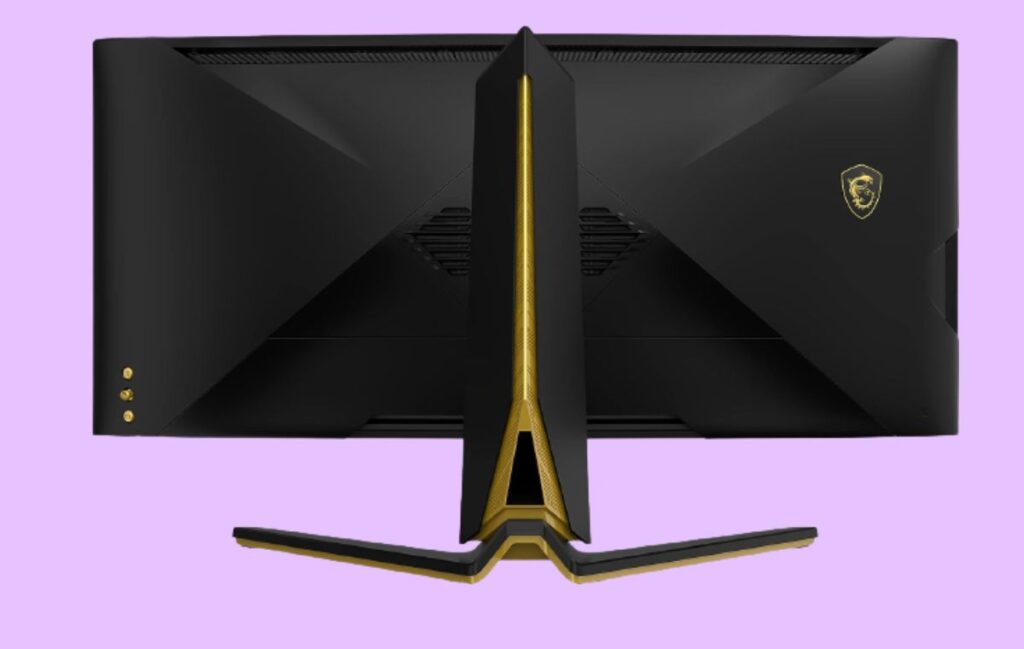
The build quality of the MSI 342C isn’t great, especially from a construction perspective. There’s a noticeable gap between the glossy display panel and the outer casing, particularly in the top right corner. Other seams like this are visible throughout, giving it a less premium feel overall. Plus, the front chin bezel is thicker than Alienware’s, making it less attractive visually. For the price, you’d expect a more polished design.
The stand is pretty basic, offering only height and tilt adjustments without rotation support. While not a big deal, it does limit how you can adjust the monitor compared to others.

As for the RGB LED strip on the front, it’s not the first time MSI and others have tried this, but I’m not sure of its purpose. During gaming, it can be distracting and doesn’t seem to offer any real benefits. There’s an option to make the LEDs match the on-screen colors, which is neat, but it’s not very practical since you’re already looking at the screen. Putting this kind of adaptive RGB ambient light on the back, creating a glow against the wall, might have been more appealing to gamers, especially with the popularity of third-party lighting solutions.

What’s interesting to me is the wide range of features available in the OSD settings, especially the KVM switch, which is not found in Alienware monitors. It also has things like customizable crosshairs, but users should be careful about potential burn-in issues, especially with OLED screens, particularly if they use smart scopes that zoom in the center. There are also features like automatic brightness control, a low blue light mode to reduce eye strain, and shadow boosting. Overall, it’s a monitor packed with impressive features.
Ports

The MSI 342C offers a genuinely useful feature with its USB-C port supporting 65 watts of charging. Compared to its competitors, MSI has an advantage with two HDMI 2.1 ports alongside DisplayPort 1.4 and USB-C with DP alt mode. In contrast, Alienware monitors only have HDMI 2.0, limiting the maximum refresh rate over HDMI to 100 Hertz. However, MSI’s setup is a bit odd. While the display supports 4K at 120 Hz downscaling over HDMI 2.1 by default in the console HDMI 2.1 setting, accessing 3440×1440 at 175 Hertz over HDMI requires switching it to PC mode. The reason for these two modes is somewhat unclear; it’s a quirk of this product.
Similar to other QD-OLED monitors, the 342C has active cooling with a low-RPM fan operating most of the time to maintain panel and component temperatures. Fortunately, the fan is nearly silent and goes unnoticed from a normal viewing distance. However, there were instances of the fan briefly ramping up to a more audible level before quickly quieting down. This happened even when the monitor wasn’t performing demanding tasks and was set at a low brightness level. Although these occurrences were infrequent, they can be bothersome. It’s possible that a firmware update could address this issue, given that this monitor supports such updates.
Screen Coating

Since the MSI 342C shares the same panel as the AW3423DW, those familiar with that review will recognize some concerns about the coating and subpixel structure of the QD-OLED panel. Unfortunately, if you were hoping that the MSI variant would handle reflections better or reduce ambient light reflectivity, this isn’t the case; it appears virtually identical to the Alienware model. For those not familiar with the coating, here’s a brief overview: The panel’s coating is glossy and lacks a polarizer, making it susceptible to reflecting ambient light under certain conditions. In typical indoor settings with artificial or natural lighting, blacks can appear more like grays or seem elevated due to light reflecting off the panel.
This is in contrast to glossy LG OLEDs, which tend to maintain much deeper black levels even with ambient light present. The level of ambient reflectivity becomes more pronounced when there’s additional light in front of the panel. However, it’s less problematic when the lighting is behind the display, and it’s a non-issue in dimly lit or dark rooms, preserving the rich OLED experience under specific viewing conditions.
OLEDs are renowned for their exceptional black levels, but with the 342C, achieving those deep blacks necessitates an optimized setup. Whether this issue is problematic or not can vary from case to case. Personally, I find it a bit bothersome and one of the notable challenges with these first-generation QD-OLED panels. However, if you predominantly game in low-light or dark environments, it’s less of a concern. At the very least, it’s something worth keeping in mind.
Read Also: Gigabyte G24F 2 Review Great For Budget Gamers
Subpixel Layout and Burn In
Regarding the subpixel structure, it’s worth noting that the MSI 342C might not be ideal for desktop productivity. The QD-OLED panel uses a triangle RGB layout instead of the traditional RGB stripe, which can cause fringing on certain high-contrast edges, especially with text. This problem isn’t easily fixed with software adjustments. Some people might not notice it, but others, like myself, find it quite noticeable, especially when compared to a standard LCD. This can reduce the sharpness and clarity of text in certain situations, although it’s not a problem for activities like gaming or watching videos.

In general, OLED monitors aren’t usually recommended for desktop use, productivity apps, or web browsing because they can suffer from permanent burn-in. So, if you plan to use this monitor mainly for content consumption, the subpixel structure might not be a big concern. However, if you intend to use it for productivity tasks, you’ll need to consider the risk of burn-in and the suboptimal subpixel layout, as well as the burn-in warranty.
MSI offers a three-year warranty that covers burn-in, as confirmed by an MSI representative I contacted. Although this information isn’t currently on their website, it’s important to have it documented somewhere for confirmation. I was told that the website will soon be updated to reflect this coverage. This warranty aspect is significant because it matches the warranty offered by Alienware models, which offer similar protection.
Response Time
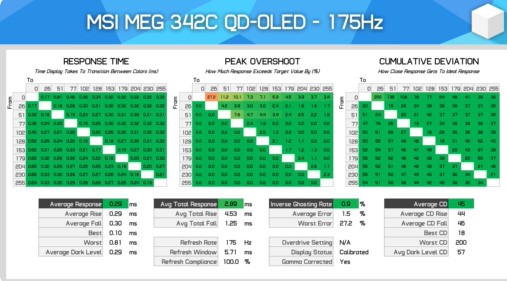

When it comes to response time, this QD-OLED panel is impressively fast, just like other QD-OLEDs we’ve tested. At its max 175Hz refresh rate, we’re seeing a speedy 0.3ms average response time. This means motion looks super clear, even at high refresh rates, without any noticeable ghosting. The 342C’s motion clarity matches the AW3423DW and beats any LCD at the same refresh rate. Plus, the deviation is remarkably low, just 45.
One great thing about OLEDs is that their performance stays consistent across all refresh rates. Whether it’s 175Hz or 60Hz, the response time stays around 0.3ms. This is unlike average LCDs, which get slower as the refresh rate drops. With the 342C, you get the same smooth experience without needing extra settings, as OLEDs don’t need them.

In terms of performance, there’s hardly any difference between Meg 342C OLED panel and others like those in Alienware monitors or the new LG 27GR95QE. They all have similar response times. The main difference is the max refresh rate, where a higher rate means clearer motion. For example, the LG monitor has a 240Hz refresh rate compared to the 342C’s 175Hz. But even at 175Hz, the motion clarity is excellent, almost as good as a 240Hz LCD and other QD-OLEDs at the same rate.
Average Gra-to-Gray
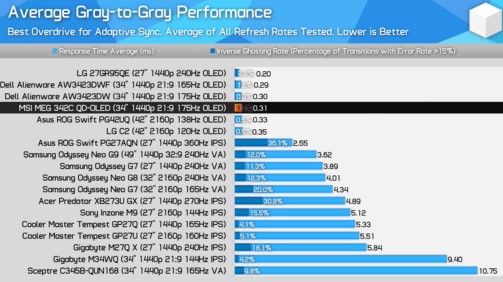
When we look at overall performance, we see how OLED compares to LCD. An average OLED display is about 10 times faster than even the top-performing LCD in its class. And OLEDs maintain this impressive speed consistently across different refresh rates with minimal overshoot. It’s hard to find any scenario where an LCD would be better than an OLED; OLEDs just perform better in terms of speed and responsiveness.
Cumulative Deviation


The cumulative deviation is again a fantastic result for the 342c, showing performance in line with other OLED products and being faster than LCDs. This display is also a great choice for gaming at 120 and 60 hertz, though at these refresh rates there will be some blur attributable to the sample and hold nature of OLED technology.
Input Lag
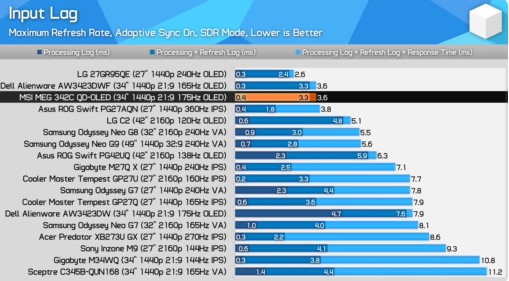
Input latency has surprisingly become a point of contention with the initial wave of QDOLED monitors. Following the AW3423DW’s less-than-stellar latency results, it’s a relief to report that the MSI model performs much better in this regard. In fact, its input latency aligns with the results from the Alienware DWF variant, both boasting latency levels of less than 0.5 milliseconds. This holds true for both SDR and HDR modes when gaming with adaptive sync enabled, making it a commendable achievement for MSI.

Power consumption tends to be on the higher side, a common trait among QD-OLEDs. Interestingly, despite not utilizing a G-Sync module, the 342C’s power consumption is roughly on par with that of the AW3423DW, with the DWF variant being slightly more power-efficient. These panels do indeed consume a significant amount of power, especially in worst-case scenarios like displaying full white, but it’s not anything extraordinary. Under typical usage conditions, power consumption falls into the sub-60 watt range, which is consistent with the behavior of other OLED displays.
Color Performance

In terms of color performance, the 342C is a wide-gamut monitor with impressive color space coverage. It delivers precisely what MSI advertises, with 99.3% coverage of DCI-P3 and a commendable 97.4% coverage of Adobe RGB. While this monitor may not be the go-to choice for color-critical productivity tasks, it still offers a substantial 80.5% coverage of Rec 2020, which is among the widest gamuts I’ve encountered, though it’s in line with other QD-OLED displays. This broad color range enhances the visual experience, especially when gaming in HDR or working with SDR content.
However, it’s worth noting that the factory calibration falls into the average to below-average range, particularly in the default mode. Grayscale performance is acceptable but not outstanding. The primary issue is the absence of a gamut clamp enabled by default, given the monitor’s wide color gamut. This results in oversaturation of SDR content, such as YouTube videos, and can lead to skin tones appearing redder than usual. Consequently, this configuration results in relatively high Delta E values.

When we compare the 342C to other monitors, it becomes apparent what I meant by average grayscale performance landing it in the mid-table and not quite as strong as the Alienware counterparts. The color checker performance, too, falls below the average mark. It’s worth noting that the DWF from Alienware doesn’t exhibit significantly better performance in this regard, so none of the QD-OLED monitors released so far are particularly impressive out of the box.
However, the 342C does have a notable strength in that MSI ships it with multiple color modes, covering sRGB, P3, and Adobe RGB. Many other brands tend to include only an sRGB mode or, if you’re fortunate, a P3 mode. It’s a welcome move by MSI to offer this variety. That said, even in the sRGB mode, the performance is only average when compared to other gaming monitors. While improvements have been made, the gamut clamp does work reasonably well to reduce oversaturation, but there are still a few lingering issues with grayscale, resulting in middling Delta E values for the color checker. These results don’t quite qualify the monitor as factory calibrated for strict sRGB usage, although the included P3 mode does show a slight improvement.

MSI advertises a Delta E2000 average of less than two, and this benchmark was indeed achieved in the saturation test. However, I found myself not particularly impressed by this mode, and by my usual standards, it still fell somewhat short of what I typically expect from a calibrated mode. Comparatively, the Alienware DWF model also features sRGB and P3 modes, and in both configurations, the Alienware model outperforms the MSI 342C in terms of color accuracy with a color checker.
That being said, the MSI 342C can be fully calibrated to deliver improved performance with the help of calibration tools like CalMan and a software profile installation. In this regard, the MSI model aligns closely with the performance of other OLED displays I’ve tested. It’s also worth noting that the MSI 342C provides a very consistent experience across various conditions. Performance remains relatively consistent regardless of the Average Picture Level (APL) of the content being displayed, which is a noteworthy improvement compared to some LG OLEDs I’ve reviewed in the past.
Brightness, Contrast, Uniformity

Max brightness is often a significant point of discussion in OLED monitor reviews, but unfortunately, there’s not much exciting to report here. If you were hoping for a brighter experience with this MSI model, you might be disappointed, as the 342C yields nearly identical results to the two Alienware monitors I reviewed previously. In the world of OLED, 240 nits is typically deemed sufficient for most use cases, although brighter would certainly be welcomed. It’s worth noting that there’s a substantial gap between these OLED monitors and LG-based alternatives, as the latter struggle to sustain 200 nits in their SDR configuration.

The minimum brightness level is also quite satisfactory at 29 nits. When it comes to contrast graphs, they can seem somewhat pointless with OLED monitors since their zero-level blacks result in effectively infinite contrast ratios. Nevertheless, it’s useful to compare the black point to an LCD to highlight the significant difference. If black levels are a concern and a critical factor for your display choice, then there’s no better option than an OLED.
Moving on to viewing angles, they are truly outstanding with QD-OLED panels, ensuring that you won’t encounter any issues related to color shifting or tint when viewing the screen from off angles. The primary consideration here would be the monitor’s curve, which may somewhat reduce the visibility of the entire screen. However, at an 1800R curvature, it aligns well with gaming at this size and aspect ratio, delivering an immersive experience.
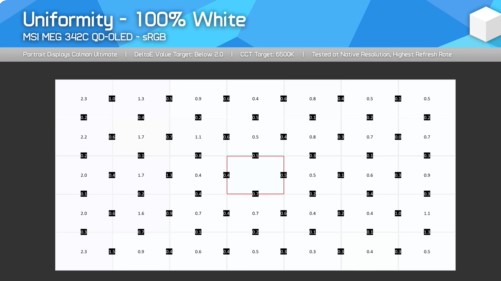
In terms of uniformity, my unit displayed performance well above the average, delivering truly excellent results. It outperformed the LG OLED 27GR95QE I examined a few weeks ago, albeit only slightly better than the Alienware counterparts I reviewed. It’s important to note that uniformity can vary somewhat between individual units.
HDR Performance

Opting for an OLED display comes with exceptional HDR performance, surpassing most HDR-enabled LCD monitors. OLEDs have genuine HDR capabilities, resulting in a significant difference in HDR image quality compared to LCDs. OLEDs achieve this by each pixel independently illuminating itself, while LCDs rely on a backlight, even with dimming zones. However, even the finest LCDs with over 2000 zones can’t match the performance of the 5 million zones found in this MSI display.
OLEDs don’t suffer from issues like blooming or haloing around bright objects, common on mini LED LCDs, thanks to their self-lit nature. While some excellent HDR LCDs exist, they struggle with intricate HDR details, unlike OLED panels like the one in the 342C, which excel in all conditions. OLEDs also have a significant advantage in black levels and overall contrast, particularly in challenging scenarios.
OLEDs achieve effectively infinite contrast ratios and genuine zero-level blacks, shining in darker scenes with intricate shadow detail. However, OLEDs, including the 342C, have a trade-off in brightness. While excelling at shadow detail, they can struggle with bright highlights, unlike LCD-based HDR, which often performs better in this aspect.
In the brightest peak 1000-nit mode, the 342C delivers around 256 nits across the entire screen, similar to other QD-OLEDs. Its brightness behavior is virtually the same as its competitors, with no distinct advantage for MSI. However, the 342C can achieve slightly over 1000 nits of peak brightness for small on-screen elements, surpassing W-OLED-based panels from LG.

Opting for an OLED display brings exceptional HDR performance, surpassing most HDR-enabled LCD monitors. OLEDs have genuine HDR capabilities, providing significantly better HDR image quality compared to LCDs. OLEDs achieve this due to their self-lit nature, where each pixel illuminates independently, resulting in impeccable HDR quality. In contrast, LCDs rely on a backlight, even high-end ones with dimming zones, which cannot match the performance of OLEDs. OLEDs avoid issues like blooming or haloing around bright objects, common in mini LED LCDs with inadequate zone counts.
While some HDR LCDs exist, even the best struggle with intricate HDR details, while OLEDs excel in all conditions, offering brilliant HDR performance. OLEDs have an edge over LCDs in black levels and contrast, particularly in challenging scenarios. Although top LCDs can achieve commendable contrast ratios, OLEDs surpass them with effectively infinite contrast ratios and true black levels. OLEDs shine in darker scenes with intricate shadow detail, but they can struggle with bright highlights due to their weakness in brightness compared to LCD-based HDR.
The Meg 342C delivers around 256 nits across the entire screen in its brightest peak 1000-nit mode, similar to other QD-OLEDs. It performs reasonably well in real-world scene brightness tests but falls short of the best LCDs. In HDR accuracy, it may rank slightly below average for a premium OLED, with issues like raised shadow brightness. Despite this, the 1000 nit mode offers a brighter HDR experience with no significant loss in accuracy compared to the True Black 400 mode.
Compared to other HDR monitors, the 342C shows a mix of strengths and weaknesses in HDR accuracy. While it may not match the calibration of elite models like the LG C2, it outperforms similar monitors like the Alienware DWF model, making it a better choice for HDR content.
HUB Essentials Checklist



The final section, the Hub Essentials checklist, scrutinizes whether MSI accurately represents its monitor and meets basic minimum performance standards. MSI earns commendation in the first two sections of the checklist. However, there are minor concerns related to a few questionable marketing images and a borderline result regarding factory calibration. Notably, the Adobe RGB mode stands out as the best in this regard, as illustrated here.


The motion performance yielded reasonable results, though it’s worth noting that 0.1 millisecond response times can be somewhat unrealistic in practical scenarios, especially without backlight strobing black frame insertion support. On the other hand, HDR performance is undeniably excellent, as the 342C offers genuine HDR capabilities with impressive brightness levels and deep blacks. However, there are some deductions in the issues section, primarily attributed to its triangle RGB subpixel layout, the potential risk of permanent burn-in, and certain peculiarities associated with the fan.
Final Thoughts
The MSI Meg 342C QD-OLED monitor is an excellent addition to the HDR gaming monitor category, combining the best features of QD OLED technology. With the same panel as other QD OLED ultrawides, it stands out in several crucial aspects. Its standout feature is its exceptional HDR capabilities, offering per-pixel local dimming, deep black levels, vibrant highlights, real-world performance, and a wide color gamut.
If you’re looking for an HDR upgrade and want an authentic HDR experience at the top tier, it’s hard to find a better option than this OLED panel. It excels for HDR gaming and content consumption. Additionally, the monitor has excellent motion performance, a natural advantage of OLED technology. With response times around 0.3 milliseconds, consistent performance across all refresh rates, and remarkable motion clarity at 175Hz, it may not reach the elite level of 240Hz OLEDs, but it still offers outstanding refresh rate similar to the motion clarity of 240Hz LCDs. It also boasts minimal input latency, ensuring a responsive user experience.
SDR performance is also good, with acceptable SDR brightness, superb viewing angles, uniformity, and a variety of included color modes. However, it’s not recommended for productivity or desktop work due to the risk of permanent burn-in and the unconventional subpixel layout. This monitor is more suited for content consumption, as the panel handles most of the heavy lifting. MSI doesn’t introduce many distinctive elements compared to other Alien ultrawides.
However, there are a few advantages that may benefit you, particularly if you need them. Unlike its primary competitors, the Alienware models, the 342C offers HDMI 2.1 support, a KVM switch, and 65 watts of power delivery via USB-C. It also provides better HDR accuracy compared to the AW3423DWF, although it’s not perfect. While it shares similar brightness levels with other QD-OLEDs, you won’t notice any significant differences in that regard.
Priced at $1,100 in the US, this display directly competes with the AW3423DWF while being more affordable than the DW model at $1,300 and the yet-to-be-reviewed Samsung G8 OLED, priced at $1,500. Unless the J8 OLED offers extraordinary features, the main battle currently lies between this MSI monitor and the DWF. One downside of the 342C is its design and build quality, which some may find unattractive. It uses mediocre materials and lacks the premium finish of the DWF. However, the MSI model compensates with advantages like HDMI 2.1 support, improved HDR accuracy, and similar overall performance.
Personally, I’m torn between the two monitors as they closely match in many aspects. Your decision may come down to minor details and regional pricing when choosing a Kodiolin ultrawide. Hopefully, this competition will lead to more competitive pricing in this monitor category. It’s encouraging to see that MSI’s version is a strong contender and can hold its ground against the competition.
Priced competitively at $1,100, the MSI 342C QD-OLED monitor offers exceptional HDR capabilities, impressive motion performance, and a variety of features. Despite some design and build quality concerns, it remains a top-tier option for those seeking an authentic HDR experience.
- Design7
- Ports9
- Screen coating and Subpixel8
- Response Time and Input Lag9
- Color Performance8
- Brightness, Contrast, and Uniformity8
- HDR Performance9

